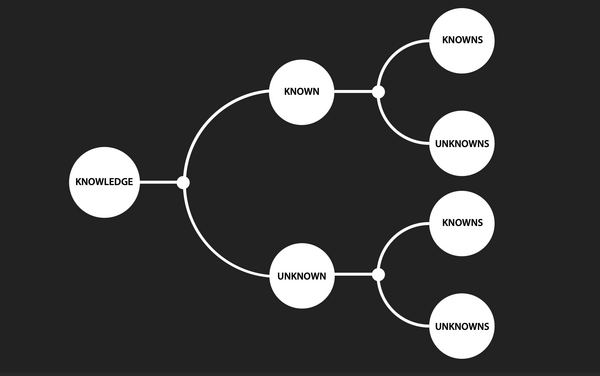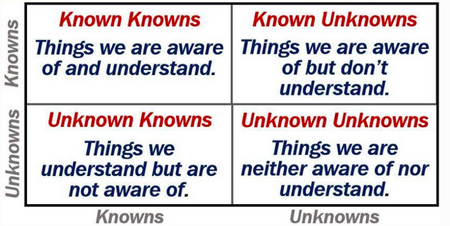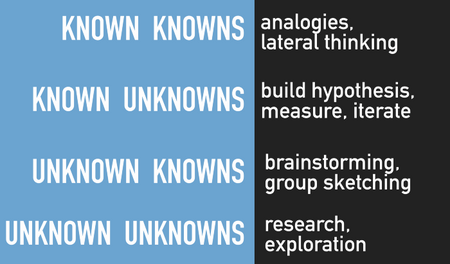Knowns and Unknowns
Developed by Dionysios Maroulis
Contents |
Abstract
This article argues about the categorization of Knowns and Unknowns. The categorization had been used since the Greek era and in many different areas of knowledge. The frameworks that will be described in this article are powerful tools to surface what we know and do not know about a problem. The first framework that will be introduced and explained is the: Knowns and Unknowns matrix that is a powerful tool for the classification of knowledge and risks, and the second one is the: The Johari window technique that improves self-awareness by providing the user with different perspectives in relation to context.
One of the most recent and well known references about this topic was from Donald Henry Rumsfeld. In response to a query about weapons of mass destruction in Iraq, former US Secretary of Defense Donald Rumsfeld said these statements at a press conference in 2002.Even though he did not come up with the concept, it became his most famous line. "Known and Unknown" is the title of his book, and director Errol Morris made a documentary about him called "Unknown Known."[1] . Rumsfeld stated:
" Reports that say that something hasn't happened are always interesting to me, because as we know, there are known knowns; there are things we know we know. We also know there are known unknowns; that is to say we know there are some things we do not know. But there are also unknown unknowns—the ones we don't know we don't know. And if one looks throughout the history of our country and other free countries, it is the latter category that tends to be the difficult ones ". Some could say that Socrates was referring to this knowledge when he first said I only know that I do not know anything. However, Ibn Yami, in the thirteenth century was the first that used these methods to categorize humas beings accordingly to their knowledge: [2]
"One who knows and knows that he knows… his horse of wisdom will reach the skies. One who knows, but doesn’t know that he knows… he is fast asleep, so you should wake him up! One who doesn’t know, but knows that he doesn’t know… his limping mule will eventually get him home. One who doesn’t know and doesn’t know that he doesn’t know… he will be eternally lost in his hopeless oblivion!".Knowns and Unknowns matrix
Known Knowns
Thinking from the perspective of knowledge, Known Knowns are facts. They are assumptions that have been validated. These facts can be static, such as that time is irreversible, but it can also be knowledge about components of a problem that change over time, for example the price or lead time for a specific component.
When it comes to risk management, known knowns are the easiest form of risk. One known indicates that the organization (company, project team) is aware of the risk. The risk may be monitored and its effects quantified, which is the other well-known aspect. The risk of not delivering the project on time is a risk that everyone knows. That time that the project may be delayed can be estimated using different techniques. These risks are the easiest to handle because the likelihood of their occurrence as well as their consequences are understood. Mathematical models can be created to assist in making decisions that reduce the likelihood and impact of such hazards. Technology, such as business process workflows, can help to automate some of these risks, allowing them to be better mitigated and even avoided. You get more information through working with them.
Lateral thinking tools, such as analogies, enable you to perceive those knowns in a new perspective, allowing you to build a parallel world to the one you know. The idea is to deviate from convention, to produce something useful and unique from something (facts) that is likely not valuable since it is already being exploited.
Known Unknowns
Knowledge base, Known Unknowns are assumptions that we have not or cannot validate.
- Assumptions that can become known knowns now if they are validated
- Assumptions that can become known knowns at some point in the future, but not now
- Assumptions that can’t become known knowns because we can’t control them.
A good example of the last category of known unknowns is the flux int the price of fuel or the price of the stocks. Also, for a construction project the estimated weather delays are classified as known unknown knowledge. Known unknowns are risks that an organization is aware of but does not know the extent or impact of. Although a company may be aware that rain may have an impact on its operations, knowing how much rain will fall makes it difficult to create specific plans. It might be a small drizzle that has no impact on operations, or it could be a downpour that completely shuts down operations. It's difficult, but not impossible, to plan for and perceive hazards. To handle known unknown risks, organizations must have a strategy for the most likely outcomes and be prepared to switch to the correct course of action once enough evidence is gathered to convert known unknowns to known knowns. Having access to specific rules and regulations on a given issue, for example, may help you evaluate the degree of risk you're taking and prepare for how much risk you'll need to run your organization-project team efficiently. Dealing with them requires making hypotheses with the Known Unknowns. In the context of Design Thinking or User-Centered Design, this generally translates to making rapid sketches or diagrams with potential solutions, which you must then pass through the team's sieve and test with users. However, these are merely concepts based on prior information. We must make certain that we express them as hypotheses rather than facts.
Unknown knowns
Unknown knowns are assumptions that might have been identified as known knowns during the planning process but were not and are now having an impact on the project. Poor communication is the most common cause of unknown knowns. A project manager is aware that a certain township only considers permission applications once a month but refuses to provide this information (or is not asked). The next project manager that works with this township has the same problem.
Thinking about risks in this category they rise because of the carelessness of an organization. These risks are rarely included in the risk management framework of an organization. This is because such risks should not exist in a well-managed risk department. However, even the finest organizations in the world are not immune to these dangers. The subprime mortgage crisis, as well as the ensuing financial catastrophe, bear witness to this.
You need to get individuals to voice their views out without too much deliberation if you want to uncover Unknown Knowns. This is met by brainstorming. The presence of a group is critical because whatever a person says might serve as a catalyst for others to bring up similar information. Also, some people will dismiss some issues because they don't fit their agenda or for other reasons, but others in the group will almost certainly address them. Unknown Knowns can also be discovered through group sketching and other forms of quick collaborative cooperation.
Unknown Unknowns
The Unknown Unknowns are true surprises also called Black swans . In this category there are no assumptions and no knowledge. Things we are neither aware of nor understand are part of this category.
These are the most hazardous dangers that an organization can face. One unknown represents the fact that the stakeholders are completely unaware of the threat. The other unknown is self-evident. This is because the organization is completely unaware of the threat. As a result, the issue of assessing and quantifying risk isn't truly raised. These hazards often have a large impact and put the organization's existence in jeopardy. Extreme weather occurrences are one example of such dangers. Another prominent illustration of this danger is the worldwide coronavirus pandemic.
You must approach a subject with an open mind in order to uncover the Unknown Unknowns. Interviews, which are frequently undertaken at the early stages of a project in user research and design study, might reveal these unknowns. In a recent project, for example, we observed that certain users were developing inventive processes using other technologies to handle their very specific difficulties. That's the type of insight that propels you forward in your knowledge of challenges and the creation of solutions.[3] [4] [5] [6][7] [8] [9]
Unfortunately I lost the updated version of my article and I have to remake it again. Please do the evaluation until the parts you can read.
The Johari window
Introduction
Moving on the next framework that provides an understanding and a methodology for Knowns and Unknowns. The Johari window model is a simple and useful tool for illustrating and improving self-awareness, and mutual understanding between individuals within a group. This model can also be used to assess and improve a group's relationship with other groups. This model is particularly useful in team development. It deals with the thinks that someone knowns or does not known comparing with the things that the rest of the group knows or doesn’t know. It also presents steps in order to jump for on category of the matrix to another one.
It was developed in 1955 by American psychologists Joseph Luft and Harry Ingham at the University of California, Los Angeles, while exploring group dynamics. In 1955, the UCLA Extension Office published the concept in the Proceedings of the Western Training Laboratory in Group Development, which was later extended by Joseph Luft. Because of the present emphasis on, and effect of,'soft' skills, behavior, empathy, collaboration, inter-group growth, and interpersonal development, the Johari Window paradigm is especially important today. The name Johari comes from the two authors, how decided to name this model after them self (JOseph and HARrIngton).
The four quadrants of Johari Window
Expanding the quadrants
Summary
Limitations
Annotated bibliography
References
- ↑ https://medium.com/@andreamantovani/known-knowns-known-unknowns-unknown-unknowns-leadership-367f346b095',Known knowns, known unknowns, unknown unknowns & Leadership'
- ↑ https://uxdesign.cc/the-knowns-and-unknowns-framework-for-design-thinking-6537787de2c5',The knowns and unknowns framework for design thinking
- ↑ https://medium.com/@andreamantovani/known-knowns-known-unknowns-unknown-unknowns-leadership-367f346b095',Known knowns, known unknowns, unknown unknowns & Leadership'
- ↑ https://thepersimmongroup.com/how-to-use-the-knowns-and-unknowns-technique-to-manage-assumptions/', How to Use the “Knowns” and “Unknowns” Technique to Manage Assumptions'
- ↑ https://www.360factors.com/blog/managing-risk-both-known-and-unknown/', Managing Risks – Both Known and Unknown'
- ↑ https://uxdesign.cc/the-knowns-and-unknowns-framework-for-design-thinking-6537787de2c5', The knowns and unknowns framework for design thinking'
- ↑ https://www.managementstudyguide.com/known-unknown-classification-of-risk.htm', The Known-Unknown Classification of Risk'
- ↑ https://info.veritasts.com/insights/unknown-unknowns-how-to-manage-risk-against-the-unexpected', Unknown Unknowns: How To Manage Risk Against the Unexpected'
- ↑ https://kiwilooseinmuseums.wordpress.com/2016/12/05/known-unknowns-rumsfeld-and-the-johari-window/', Known Unknowns: Rumsfeld and the Johari Window'


